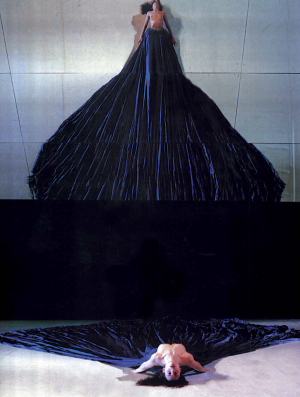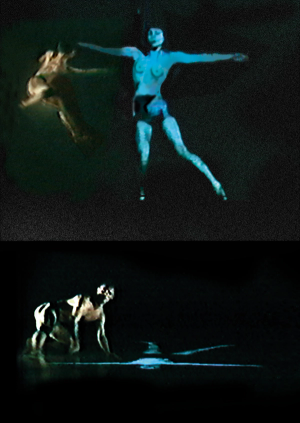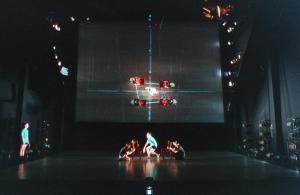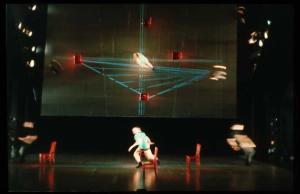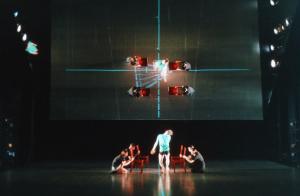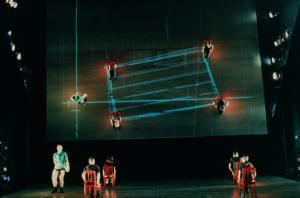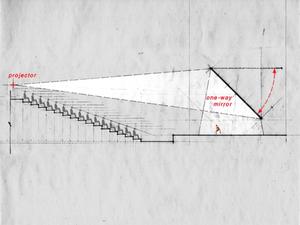MOVINGTARGET
CHARLEROIDANSES,CHARLEROI,BELGIUM
Loosely based on the uncensored diaries of famed dancer Vaslav Nijinsky, Moving Target explores the changing definitions of the terms “normal” and “pathological.” It takes on human norms as well as those of the theater.
In contrast to a conventional proscenium arch, which frames the narrative space of a theatrical stage, Moving Target makes use of an “interscenium.” A large one-way mirror is suspended above the stage. Tilted forty-five degrees with respect to the floor, the mirror splinters the gaze of the audience into a frontal view and a reflected overhead view. The mirror tips the ground up by ninety degrees, simultaneously freeing the live dancer from the confines of gravity and offering the audience a privileged perspective that reveals choreographic structure.
Video projections, which the mirror reflects onto the stage, synthesize the spaces of stage and screen, while generating new virtuosities. Dancers, prerecorded on video and projected in performance, are liberated from the limitations of the body: their movements are heightened through digital video morphing. A physical dancer, suspended behind the one-way mirror, appears phantomlike as they perform a pas de trois with projected and corporeal counterparts. Video wipes, dissolves, and zooms are used outside the typically strict video syntax to alter the spatial and temporal conventions of the stage, thus producing friction between the live and mediated performers.
Real-time computing is added to the visual matrix. An optical tracking system, modeled on technology developed during the Gulf War, monitors stage activity. The system is trained in pattern matching: a computer-aided camera looks for particular colors — green and red — and rough shapes as it reads the location, direction, and velocity of these moving targets. A defiant dancer wears a green costume, while four red chairs are used to mark the changing quadrangle of a virtual cage. The computer organizes the four red points and connects the lines between them, tracking the defiant dancer as he tries to escape the shifting boundaries. The computer is a character onstage, alive and thinking.
The work has an alternative temporal structure. Rather than being divided into discrete acts and scenes, Moving Target is continuous — interrupted only occasionally by a series of advertising spots. The multimedia commercials are considered “psychotic breaks,” intended to conflate the theater audience with a television audience. The five spots make up an advertising campaign for the fictional Normal Pharmaceuticals company, whose tagline is “Normalization for a post-psychotherapeutic culture.”
Moving Target was created in collaboration with choreographer Frédéric Flamand, Charleroi Danses, and immersive media designer Kirk Woolford. The work was first performed in Charleroi, Belgium, and was subsequently presented in Thessaloniki, Berlin, Cannes, and Marseilles.
| Location Charleroi Danses, Charleroi, Belgium |
| Team | Elizabeth Diller,Ricardo Scofidio,and Patrice Gardera |
| Frédéric Flamand | Choreographer |
| Kirk Woolford | Immersive Media Design |

